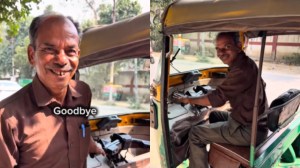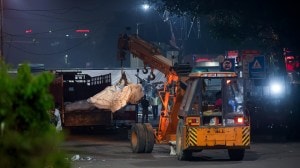The Great Indian Road Show Crawls
Sher Shah Suri built the Grand Trunk Road and gave India, according to Rudyard Kipling, a river of life. The BJP Govt is not talking in thos...

Sher Shah Suri built the Grand Trunk Road and gave India, according to Rudyard Kipling, a river of life. The BJP Govt is not talking in those terms, yet. What it promised was state-of-the-art, four-lane highways linking Delhi, Mumbai, Kolkata and Chennai by Dec 2003.
But four years later, the wagon is sputtering, with just one-fourth of the 5,846-km stretch ready and targets scaled down. The Indian Express travelled along the Golden Quadrilateral and found usual suspects, unexpected potholes and surprise freeways.
If Satara’s fancy for flyovers has grounded work, Rajasthan villages have cleared way without waiting for relief in the name of national interest. Beginning today, we take you on a journey of this highway.
It is rollback time for Minister of State for Road, Transport and Highways B.C. Khanduri. After claiming from every nook and cranny of the country he visited in the past year that the Prime Minister’s dream four-lane highway project, The Golden Quadrilateral, connecting the four metros, will be ready by December 2003, the minister is now eating his words.
Four years after PM Atal Behari Vajpayee laid the foundation stone for the project at Devanahalli in Karnataka, the National Highways Authority of India (NHAI) has just completed 1,327 of the 5,846 km-long Golden Quadrilateral (GQ). With the monsoon season ahead, NHAI effectively has just four to five months to fulfill what is now a far-fetched dream.
In fact, despite all the incentives for quick work and threats of penalty to contractors for delays, NHAI officials seem to have seen this coming long back. Ask any official about the project and pat comes the reply: ‘‘The minister (Khanduri) said ‘substantial completion’, which means that at least two of the new four lanes will be ready by December 2003.’’
With just seven months left for the deadline, the word ‘‘substantial’’ is everyone’s best defence. But as The Indian Express found out, it means different things at different places. On the Delhi-Kolkata route, 60 per cent of two new lanes by December constitutes ‘‘substantial’’ completion while officials on the Kolkata-Chennai section quote a figure of about 80-90 per cent.
NHAI engineers between Mumbai and Chennai stick to the redefined version of completing two lanes by December. The Delhi-Mumbai stretch is, however, on course for timely completion. So, after working out the averages, this is what Khanduri has to say: ‘‘I advanced the deadline by a year to December 2003 to change the mentality of delays and cost overruns which is like a virus among the engineers of our country. Now I hope that 80 per cent of the new two-lanes will be completed by December. The entire Golden Quadrilateral is not possible.’’
But there is a catch in Khanduri’s revised, two-lane pledge: Contractors point out that it clashes with the milestone chart set in their contracts, which envisages four lanes, and could result in penalties for them. Take the case of the 61 km road between Sikandara and Bhaunti (short of Kanpur) in UP.
According to the contract, 40 km of all four lanes were to be completed by Dec 25. However, the minister is now asking for just two new lanes over the entire 61 km. The reason for Khanduri’s rollback is clear. With elections near, he wants to go to the public with something concrete by the stated deadline than scattered pieces of the promised quadrilateral. But some contractors are worried they may become pawns in this political game.
‘‘The minister can change tomorrow, what will be our fate then? The penalties will be applied as per the milestones mentioned in the contract. May be a revision of targets to the ministry’s requirement is officially possible in sections funded by NHAI but in projects financed by international monetary institutions like the World Bank, the contract cannot be easily changed,’’ says a contractor on condition of anonymity.
Khanduri conceded to The Indian Express that contractors have raised this objection. ‘‘They do bring up this point. In which case, they can abide by the terms of the contract. But by advancing the deadline, at least I have ensured that the GQ will be constructed fully by the projected date of completion in the contract, which is December 2004.’’
Figures, however, tell a different story. The February flash report of the Ministry of Statistics and Programme Implementation states that 50 (of the 90) sections of the Golden Quadrilateral have registered delays. Of these, 10 sections have been delayed by up to two years, with the graph maintaining a similar trend for the past few months.
In addition, seven of the 15 World Bank-funded projects between Delhi and Kolkata were awarded a year late in 2002. Since most international lending agencies have stringent norms about rehabilitation of the project affected, including encroachers, construction on sections funded by these institutions has been grossly delayed. An internal note of NHAI rates the progress in West Bengal as less than 50 per cent.
On the December 2003 deadline for the Kolkata-Chennai stretch, Col B.K. Moitra, one of the consultants, says: ‘‘It is a difficult task. But we will not say it is impossible.’’ Col Moitra and his team members are praying for a moderate monsoon to help speed up construction.
On the road from Mumbai to Chennai, the Golden Quadrilateral’s progress is so bad at places beyond Dharwad that NHAI officials plead: ‘‘Please don’t publish the figures. They are pathetic.’’
At many places, NHAI has failed to fulfill the condition to provide a clear site to the contractor before the first bulldozer rolls out. The acquisition of land, demolition of structures, uprooting of trees, removal of encroachers and relocation of electrical poles are tasks which involve different state departments, and hence as many hurdles.
NHAI has not been able to acquire land in most states, particularly Uttar Pradesh, Orissa, Tamil Nadu and Karnataka. For instance, of the 916 hectares land needed in Tamil Nadu, only 119 hectares have been officially acquired, while 490 hectares had been obtained by public consent till March 31.
Bearing in mind the deadline diktat of December 2003, NHAI had asked contractors to begin work simultaneously. So, even in many of the better performing stretches, there are tracts which remain to be cleared.
While this measure may have got the project off the blocks, it has also taken the teeth out of the penalty clause. Contractors who are behind schedule like China Coal Construction Group Corporation in UP hide behind the excuse that NHAI was not able to hand them a clear site on time.
In Bihar and Jharkhand where land acquisition is almost complete, there are issues of law and order. From local gangs to Maoist insurgents, all are demanding their pound of flesh from contractors. While NHAI says take police protection, contractors have more faith in negotiating matters themselves. Many of them have employed five to six times more labourers and supervisors just to keep various groups happy.
None of this, however, prevented Maoist groups from attacking a crushing site near Aurangabad on January 31. The same group had attacked the neighbouring contractor’s camp the previous day and the company could not muster courage to restart work on the section till the first week of April.
The one silver lining in this golden dream is the stretch from Delhi to Mumbai. By December, nearly 80 per cent of all four lanes of the stretch will be ready. And by June 2004, leaving 142 km, all four lanes of the 1,419 km would be open for traffic, cutting down travelling time between the two metros by 30 per cent.
The portion where contractors are running behind schedule on this stretch is from Surat to Mumbai. Here the deadline given was October 2003, but the entire stretch is only likely to finish by June next year. Cashflow problems and protests by local quarry owners over price quotations put back work by at least six months.
Incidentally, this is the busiest corridor in the country, catering to nearly 13,000 trucks everyday, and protracted traffic jams are an everyday affair.
But mostly it has been smooth sailing for NHAI here, particularly in Rajasthan, with almost no litigation as far as compensations go. People who have lived along the highway for years have pulled down their homes and shops with just a ‘‘consent possession form’’ from NHAI. Refreshingly, the popular perception is that they should not come in the way of ‘‘work of national importance’’. Now it is up to the Government to live up to this promise.
(Tomorrow: NHAI in a fix as prestigious foreign contractors fumble in Indian terrain)



- 01
- 02
- 03
- 04
- 05




























